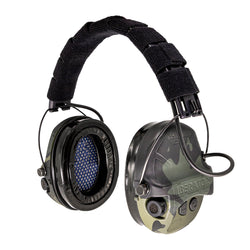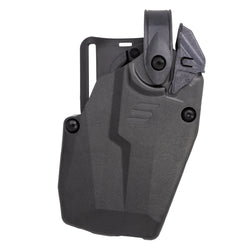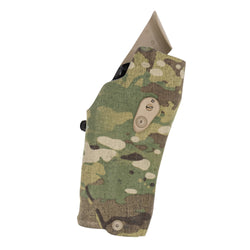Safariland is calling the Ballast the most advanced duty holster ever produced. It integrates features of the 7000 series and the Vault to create a lightweight, heavy-duty, and modular holster system.

The Design
The Ballast addresses complaints about duty-style polymer holsters that have existed for years.
Polymer remains the only acceptable modern material for a duty holster. It’s known to be tough and weather-resistant, but like anything, it can break. A heavy impact can crush a polymer holster, causing it to split or, in some cases, preventing the gun from being drawn.
To counter that, the Ballast uses a crush-resistant design. Specifically, a ring of material encircles the entire holster, reinforcing it for that crush-proof performance.
Of course, with strength often comes weight. Weight and bulk are a problem. The modern duty belt is already a crowded platform, and it’s well documented that heavy-duty belts contribute to chronic back pain among law enforcement officers.
That’s not a problem with the Ballast. Safariland recognized the problem and built the Ballast to be light. It’s their lightest duty holster ever. Even small weight reductions can be beneficial, and the Ballast aims to be a welcome reprieve in the world of duty holsters.

Mind the Gap
Problem-solving is the name of the game. The Ballast also features a flexible ingress guard—a solution to a common issue with holsters designed for weapon-mounted lights, which often leave a gap around the trigger guard.
Gaps attract trouble in the form of debris, gunk, various other elements, and dongles. What dongles? The kind that can fit in gaps.
That’s bad for a number of reasons. To fix the gap, Safariland has positioned a flexible ingress guard between the grip and trigger. It’s a fairly soft and flexible piece of material that seals the gap up and makes it disappear.

Modularity Matters
The Ballast also offers modularity — one of the best things I’ve heard it called is the “Lego holster.” You can modify the holster to work with a series of firearm sizes.
For example, the Glock 19 and Glock 17 are similar but traditionally couldn’t share holsters. With the Ballast, you can swap the bottom of the rig to work with both sizes, as well as both large and small weapon lights.
Departments often issue various-sized firearms and accessories depending on their roles, so having one holster that fits multiple guns and officers is a huge advantage.

The Ballast still works with the Safariland 3-Hole ecosystem, which is full of attachments for nearly any scenario and method of carrying a firearm.
I also want to mention the optics cover. As a red dot user, I want my optics protected, especially if they’re an open emitter.
As a Florida resident, I adore the optics cover.Our weather changes a lot here, and classes and competitions will be shot in the rain if that’s what we have to do. The cover keeps rain, dirt, dust, and whatever else the world throws at us off our optics.
I’ve tested the optics cover in a hurricane. It was a small hurricane, but it kept my optics dry!

Retention and Security
The Ballast is a Level 3 duty rig, meaning you must make three movements to free your gun. A Level 3 Safariland holster combines the SLS hood and the ALS lever.

To free the gun, you have to push the SLS down, push the SLS forward, and then pull the ALS rearward. These three distinct movements ensure that your gun is locked into the holster. Only the person wearing the gun can quickly free the weapon from the holster.

This provides a level of security necessary for uniformed police officers without making the gun challenging to draw. Users will have to train and practice with the platform, but developing a rhythm of push down, push forward, and pull rearward isn’t tricky and allows for a quick and effective draw.
The Ballast In Action
After the Ballast’s reveal at SHOT 2025, I saw a number of interesting criticisms focused on the ingress guard. Many assumed it would make it difficult to get a proper grip on the firearm and would create a grip gap. That’s simply not true.
The ingress guard’s flexible nature and design allow for a nice, high grip on the gun. It’s never in the way, and I can easily draw my Ruger RXM, which is Glock 19-sized. I can always establish a good grip on the gun and present it properly.

I could draw the gun in about 1.5 seconds cold. That’s pretty quick for a Level 3 duty rig. As I warmed up, the time got dropped fractions of a second. Getting into that rhythm makes all the difference when using the SLS and ALS systems.
I practiced dry and live, and anyone using a duty holster should get plenty of practice. The first live fire drill I fired was the No Fail Pistol Drill, which calls for a 25-yard shot from the draw in 3.5 seconds on a small target. I had no problems with my time, but I had more than a couple of accuracy problems—that’s me, not the holster.

Drawing to shoot close-range drills, like the Bill Drill, proved interesting. I’ve never been a sub-2-second Bill Drill guy.
With the Ballast, I scored a 2.8 on my first semi-cold run. Again, that time was driven down by fractions of a second with every run.
Going Hard and Fast
I can’t simulate a gunfight or create an adrenaline rush on demand, but I could at least get my heart rate up and my blood flowing. I don’t have a gym at my range, but I can bring kettlebells and run sprints.
I got my heart rate up with 100-yard sprints and a mixture of kettlebell swings and overhead presses. Sometimes, you have to get sweaty and out of breath to test a holster. My previous practice with the SLS and ALS paid off as my heart rate raced.

I could draw and put a round inside an IPSC A-Zone in 1.73 seconds at seven yards. With practice, I got faster and was drawing almost as quickly as I could without my heart racing.
I also integrated cover and kneeling positions and had no issues drawing or using the Ballast holster. An elevated heart rate and awkward positions didn’t compromise its effectiveness.
Getting the Ballast
The Ballast has proven to be Safariland’s most advanced duty holster. It’s lightweight, incredibly strong, and still offers the same level of retention we are used to. The Ballast does it all while being smaller and modular.
It was worth the wait.









